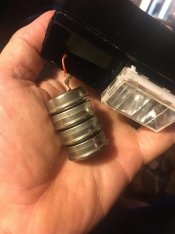AndyH
Member
I have a couple of old Bauer E 160 Ultrablitz electronic flashes that I'd like to restore to functionality. I love the compact size and the relatively high output, and they look great with many of my old film cameras. They have both hot shoe and PC to PC adaptability. Back in film days, they were my favorite units, and I always had one along in case of need.
The capacitors charge and the flashes work on AC power, but the batteries appear shot and won't hold a charge. Although I'm fairly handy with repairs and modifications, I've never attempted to replace rechargeable batteries in a flash unit.
I'd appreciate any advice on whether this is a reasonable thing to attempt, and on possible sources for replacement NiCads. It seems like it should be a relatively easy feat with a modicum of soldering skills and the ability to disassemble the case. Both of these units are in otherwise mint condition, and a quick test of exposure under AC power indicated that they were putting out pretty close to full power.
Any advice before I start the process? (I already know that I need to make sure the capacitor is fully discharged before opening it up)
Thanks in advance for any tips or thoughts!
Andy
The capacitors charge and the flashes work on AC power, but the batteries appear shot and won't hold a charge. Although I'm fairly handy with repairs and modifications, I've never attempted to replace rechargeable batteries in a flash unit.
I'd appreciate any advice on whether this is a reasonable thing to attempt, and on possible sources for replacement NiCads. It seems like it should be a relatively easy feat with a modicum of soldering skills and the ability to disassemble the case. Both of these units are in otherwise mint condition, and a quick test of exposure under AC power indicated that they were putting out pretty close to full power.
Any advice before I start the process? (I already know that I need to make sure the capacitor is fully discharged before opening it up)
Thanks in advance for any tips or thoughts!
Andy












